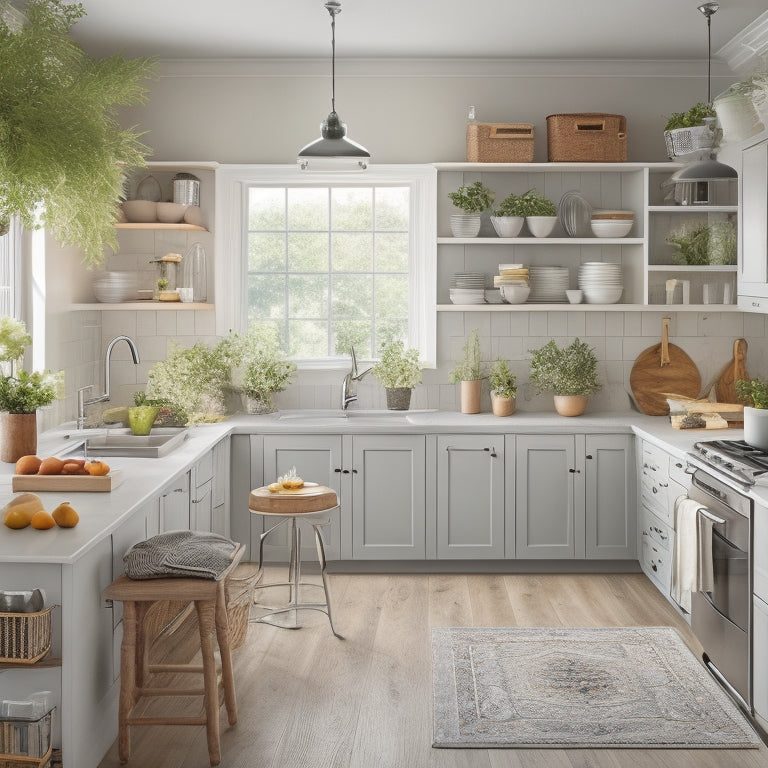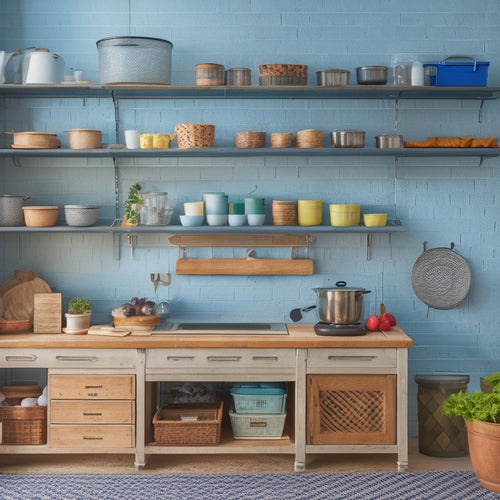
Organize Your Tiny Kitchen in 7 Easy Steps
Share
You're about to change your tiny kitchen into a functional, clutter-free space that sparks joy and simplifies meal prep, all in just 7 easy steps. Start by clearing off countertops completely, purging unwanted items, and assigning a home for each remaining one. Employ vertical storage spaces, optimize cabinet organization, and create a functional workflow to maximize efficiency. Next, focus on maintaining your new order with daily tidying, weekly deep cleans, and monthly decluttering sessions. By following these steps, you'll be well on your way to a kitchen that's both beautiful and functional - and we'll show you exactly how to make it happen.
Key Takeaways
- Clear off countertops completely by sorting items into categories and identifying essentials to create a clean slate.
- Purge unwanted kitchen items by donating duplicates, recycling broken containers, and removing seasonal items to free up space.
- Assign a home for each item by designating specific areas for food preparation, cooking, and storage to maintain organization.
- Utilize vertical storage spaces by installing shelves, hooks, and racks to maximize storage capacity in small kitchens.
- Create a functional workflow by dividing the kitchen into zones and streamlining workflow to minimize walking distances between zones.
Clear Off Countertops Completely
Since you're about to commence an expedition to organize your tiny kitchen, it's vital to start with a clean slate - or rather, a clear countertop.
Clearing off countertops completely is the first step in tackling kitchen clutter. Begin by removing everything from your countertops and sorting items into categories. Identify your countertop essentials and prioritize what you need immediate access to.
Consider investing in space-saving gadgets and organization tools to maximize storage. When evaluating your living spaces, remember to opt for a clutter-free environment that reflects your lifestyle needs.
Adopt a minimalist approach and opt for decorative storage solutions that serve a purpose. Establish a daily cleaning routine to maintain your newly organized space.
With a clear countertop, you'll be able to focus on the next steps in organizing your tiny kitchen.
Purge Unwanted Kitchen Items
Your kitchen's overstuffed drawers and cluttered shelves are a reflection of the gadgets and gizmos you've accumulated over the years, but it's time to face the music: not everything deserves a spot in your tiny kitchen.
It's time to purge unwanted items, keeping only what's functional and essential.
-
Donate duplicates: If you have multiple items serving the same purpose, consider donating the extras to free up space.
-
Recycle containers: Get rid of broken or unusable containers, and recycle those that are still in good condition.
-
Seasonal decluttering: Remove seasonal items, like holiday-themed dishes or summer cookware, to make room for everyday kitchen essentials.
Assign a Home for Each Item
You'll want to designate a spot for each item, so everything has a specific place to go back to after use.
Store heavy items, like pots and pans, near the stove or cooking area to save time and energy.
Designate a Spot
To maximize the efficiency of your tiny kitchen, it's essential to designate a spot for each item, ensuring everything has a home and can be easily accessed when needed.
This approach helps you maintain a clutter-free kitchen layout and saves you time searching for items.
Identify the following key areas in your kitchen:
-
Countertop zones: Designate specific areas for food preparation, cooking, and storage.
-
Cabinet assignments: Allocate specific cabinets for dishes, cookware, and food storage.
-
Drawer organization: Designate drawers for utensils, cleaning supplies, and other essentials.
Store Heavy Items
Assigning a home for each item in your tiny kitchen means storing heavy items in a way that makes sense for your layout and workflow. You need to make sure that your storage solutions can handle the weight of your heavy kitchen essentials.
Install shelf brackets or heavy-duty shelves to support bulky items. Use storage bins and under-shelf storage to keep heavy items contained and organized. Consider investing in kitchen carts with load-bearing hooks to maximize your storage capacity.
Don't forget to distribute weight evenly to avoid straining your shelves. Protect your floors with appliance mats to prevent scratches and damage.
Use Vertical Space
Since every inch counts in a tiny kitchen, using vertical space is essential to maximizing storage and keeping countertops clear.
You'll be amazed at how much more organized your kitchen can be when you take advantage of wall space.
Here are 3 ways to use vertical space effectively:
-
Install shelf brackets or floating shelves to store less frequently used items, like special occasion dishes or cookbooks.
-
Use wall hooks or hanging racks to hang pots, pans, utensils, and even aprons, freeing up cabinet space.
-
Utilize magnetic strips, pegboards, or ladder shelves to store spices, oils, or frequently used items, keeping them easily accessible.
Utilize Vertical Storage Spaces
Your tiny kitchen's walls are prime real estate for maximizing storage. Take advantage of this vertical space by installing shelf risers, wall-mounted racks, and ladder shelves to store infrequently used items.
Hang pots and pans from hooks or a pegboard to free up cabinet space. Use magnetic strips to store spices, oils, or frequently used utensils. Over-the-door organizers can hold snacks, cleaning supplies, or kitchen tools.
Tiered shelves and vertical dividers can separate and categorize items, keeping them organized and easy to access. Finally, consider basket stacking to store dry goods, linens, or cleaning supplies.
Optimize Cabinet Organization Systems
Maximize the potential of your cabinet organization systems by incorporating adjustable shelves, baskets, and dividers. This will enable you to customize your storage spaces according to your needs.
Implement cabinet layering techniques to increase storage capacity and reduce clutter.
- Adjust shelf heights to accommodate items of different sizes, ensuring everything fits snugly.
- Use baskets to store smaller items, keeping them organized and out of sight.
- Install dividers to separate items within a shelf, maintaining a sense of order and structure.
Create a Functional Workflow
You'll want to allocate your kitchen into zones, such as cooking, prep, and storage, to create a functional workflow.
This will help you optimize your workspace efficiency by minimizing walking distances and maximizing your productivity.
Kitchen Zone Allocation
The kitchen triangle - a fundamental concept in kitchen design - is the foundation of an efficient workflow.
By dividing your kitchen into designated zones, you'll create a clutter-free space that streamlines meal prep and cooking.
Assign these three zones to optimize your kitchen's layout:
-
Cooking Zone: Place your stove, oven, and cooking utensils in this area to minimize walking distances while cooking.
-
Storage Solutions Zone: Designate a zone for your pantry, cabinets, and shelving to keep ingredients and cookware organized and within reach.
-
Meal Prep Zone: Allocate a space for food preparation, including countertops, sinks, and utensils, to create an efficient workflow for chopping, mixing, and assembling meals.
Optimize Workspace Efficiency
Your kitchen's workflow is only as efficient as the path you take to complete tasks. By optimizing your workspace, you'll reduce clutter, save time, and enjoy cooking again. Start by identifying your most-used kitchen gadgets and meal prep stations. Then, assign each task a designated zone to maintain a smooth workflow.
| Task | Zone |
|---|---|
| Meal Prep | Countertop near sink |
| Cooking | Stovetop and surrounding area |
| Cleaning | Sink and adjacent countertops |
| Storage | Upper cabinets and pantry |
| Food Prep | Island or cart with utensils |
Maintain Your New Order
Establishing a sense of order in your tiny kitchen is only half the battle - the real challenge lies in maintaining it.
To guarantee your space remains organized and clutter-free, you'll need to commit to regular kitchen maintenance. This means incorporating simple habits into your daily routine, such as:
-
Daily tidying: Take a few minutes each day to wipe down countertops, put away dishes, and straighten up your cooking station.
-
Weekly deep clean: Schedule a weekly deep clean to tackle tougher tasks, like cleaning the oven or refrigerator.
-
Monthly decluttering: Set aside time each month to purge items you no longer need or use, and reassess your storage solutions to guarantee they're still working for you.
Frequently Asked Questions
How Do I Deal With Limited Drawer Space in My Tiny Kitchen?
Sift through your storage struggles by separating similar items with drawer dividers, then shift your focus to vertical storage solutions, like shelves or baskets, to maximize your tiny kitchen's limited drawer space.
Can I Organizers Be Used in Non-Standard Sized Kitchen Cabinets?
You can definitely use custom organizers in non-standard sized kitchen cabinets, finding creative solutions to maximize space. Measure your cabinets, then shop for or DIY custom inserts, shelves, or dividers that fit your unique needs, giving you total control over your kitchen organization.
Are There Any Stylish Options for Hiding Trash Cans and Recycling Bins?
As you're tackling kitchen clutter, it's likely you're also thinking about hiding unsightly trash cans. You'll be relieved to know that decorative bins and pull-out cabinets are stylish solutions that'll keep your kitchen looking sleek and organized, giving you the control you crave.
What Are Some Space-Saving Ideas for Kitchen Appliance Storage?
You'll maximize kitchen real estate by storing appliances on multi-tier racks or attaching them to magnetic strips on walls or cabinets, freeing up countertops and keeping frequently used items within easy reach.
How Often Should I Reassess and Adjust My Kitchen Organization System?
You should reassess your kitchen organization system regularly, ideally every 3-6 months, to guarantee it still meets your needs; make seasonal adjustments to optimize storage and workflow, and maintain a frequency assessment to stay on top of changes.
Related Posts
-

Maximize Space With These Top Organization Apps
You're just a few clicks away from maximizing your space and time! Start by decluttering your digital life, then opti...
-

10 Budget-Friendly DIY Kitchen Space Hacks
You can release the full potential of your kitchen space without breaking the bank by incorporating creative, budget-...

